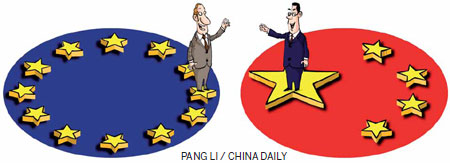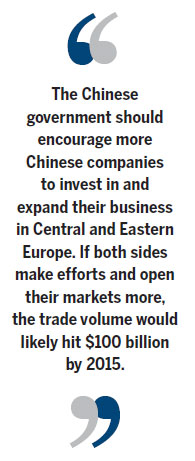Old allies turn new partners
Updated: 2012-05-04 11:01
By Feng Zhongping (China Daily)
|
|||||||||||

Central and eastern european nations have had long-lasting ties with china; now is the time to expand them
All those interested in the development of the China-Europe relationship would have noticed the recent intensive interaction between China and countries in Central and Eastern Europe.
On April 25, Premier Wen Jiabao arrived in Warsaw, signaling the first formal visit of a Chinese premier to Poland for 25 years. During that visit, Wen attended a China-Central and Eastern Europe leaders' meeting, a first in the history of the relationship between the two sides.
 |
Close on his heels was Vice-Premier Li Keqiang's Europe tour, in which Hungary was on the agenda, as was Belgium, headquarters of the European Union. Two visits in the space of a week by Chinese leaders to Central and Eastern Europe is a strong signal that the relationship between the two sides is building strong momentum.
Many Chinese would say that he or she has a fondness for Central and Eastern Europe. They still remember that during the Cold War, when the world was divided into two camps, Western countries adopted a policy of isolation against China while most countries in Central and Eastern Europe quickly established diplomatic relationships. As a result, these countries have become major partners in China's cooperation with the world.
The long-lasting mutual cooperation and friendship was a key ingredient of their mutual relationships. The title "Strengthen Traditional Friendship and Promote Common Development" of the speech delivered by Wen at the first China-Central and Eastern Europe Economic and Trade Forum last year reinforces the point.
At the second forum this year, Wen again highlighted the importance of traditional friendship in mutual relationships: "Although phenomenal changes have taken place in both the world and in our countries, both sides have always understood and supported each other on respective issues of sovereignty and territorial integrity."
This traditional friendship has forged a special relationship and cooperation between China and the countries in a wide range of fields, which is an embodiment of the economic complementarity of the two sides. Strengthening cooperation is to the benefits of both sides.
After the Cold War finally came to an end, huge changes have taken place in Europe and the world at large. The development goals and diplomatic strategy of Central and Eastern Europe countries have seen major changes. For about 15 years, the main goal of the diplomacy of countries including Poland and Hungary was entry to the EU. "Return to Europe" was the concept most governments in the region conveyed to their peoples as they tried to meet the criteria for EU membership.
Another important goal of these countries was to join the NATO; or in other words, relationship with the US was another priority.
We can say that for a long time after the Cold War, the Central and Eastern European countries veered more toward the EU as well as the US.
In 2004, eight countries including Poland, the Czech Republic and Hungary joined the EU; and Bulgaria and Romania joined three years later. All Central and Eastern European countries joined NATO in the meanwhile. Since then, they have realized the diplomatic goal they set when the Cold War ended. While completing this task, these countries started to attach greater significance to the relationship with new economies, China included. That relationship with China has grown keener since the breakout of the international financial crisis and the European debt crisis.
In 2001, their trade volume with China was worth only $4.3 billion (3.3 billion euros), but a decade later, the figure reached $52.9 billion, with an annual growth of 27.6 percent. What needs to be highlighted is that the annual growth rate of Chinese imports from these countries reached 30 percent since the beginning of the crisis, a figure that goes against the overall trend. Nevertheless, huge imbalances exist in mutual trade.
The solution, in the eyes of the Chinese side, is to import more goods, and offer convenient services for the companies in this region to attend exhibitions and trade fairs in China.
Wen said at the second economic and trade forum that China will send a group to the region to improve trade and investment, which will undoubtedly increase trade volume, especially China's imports.
Meanwhile, the Chinese government should encourage more Chinese companies to invest in and expand their business in Central and Eastern Europe. If both sides make efforts and open their markets more, the trade volume would likely hit $100 billion by 2015.
In the coming years, there will be bright prospects for investment in infrastructure even though setbacks encountered by China Overseas Engineering Group Co Ltd (COVEC), a Beijing-based subsidiary of China Railway Engineering Corp, in Poland have sparked some worries among investors. COVEC withdrew from a $447 million highway construction project in Poland in the first half of 2011 after incurring potential losses of $394 million.
However, I think this case should not cast a shadow on cooperation in infrastructure construction. Central and Eastern European countries have a huge need for infrastructure construction, while Chinese enterprises have the skills, experience and competitive prices in planning, design and construction.
At present, China is implementing its 12th Five-Pear Plan (2011-15), and Europe the "Europe 2020 Strategy". There are many convergences of interest in renewable energy, urban development and technological innovation.
As the two sides develop economic and trade ties, they should also value cultural exchanges. In China, there were many experts on the research of language and culture in that region, whose efforts have brought China and those countries closer, leaving a good impression in the minds of many Chinese. But now since many of them have retired, it is an urgent task to bring in new experts. Chinese universities and their counterparts in Central and Eastern Europe should increase the number of exchange students and set up more scholarships to attract young people.
Overall, new economies in the EU, the Central and Eastern European countries are different from Western European countries in their development mode. China has every reason to treat them as special friends under the framework of the China-EU Strategic Partnership.
The author is the director of the Institute of European Studies at the China Institutes of Contemporary International Relations. The views do not necessarily reflect those of China Daily.
Today's Top News
Rescuers race against time for quake victims
Telecom workers restore links
Coal mine blast kills 18 in Jilin
Intl scholarship puts China on the map
More bird flu patients discharged
Gold loses sheen, but still a safe bet
US 'turns blind eye to human rights'
Telecom workers restore links
Hot Topics
Lunar probe , China growth forecasts, Emission rules get tougher, China seen through 'colored lens', International board,
Editor's Picks

|

|

|

|

|

|





